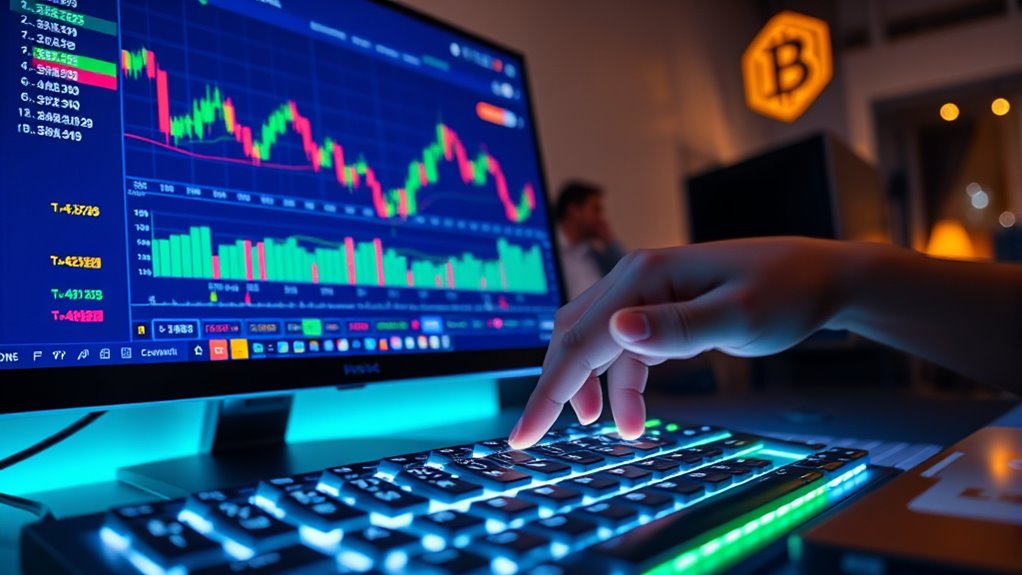To trade on a DEX, connect your crypto wallet like MetaMask or Trust Wallet, then select the tokens you want to swap. Make certain you set your slippage tolerance and review transaction details carefully. Confirm the swap and wait for it to process on the blockchain. Since DEXs don’t hold your funds, always use reputable platforms and keep your private keys secure. Staying informed about liquidity pools and security tips helps you trade with confidence—there’s more to explore to become a pro.
Key Takeaways
- Connect your crypto wallet (e.g., MetaMask) to the DEX platform to access your funds.
- Select your desired trading pair and specify the amount you wish to swap.
- Review transaction details, set slippage tolerance, and confirm the swap.
- Add liquidity to pools by depositing equal values of two tokens if providing liquidity.
- Monitor transaction status and security measures, ensuring platform legitimacy before trading.

Have you ever wondered how decentralized exchanges (DEXs) are transforming the way people trade cryptocurrencies? Unlike traditional centralized platforms that rely on order books and intermediaries, DEXs operate on blockchain technology, giving you direct control over your funds. To get started, you’ll need to connect your crypto wallet—such as MetaMask, Trust Wallet, or another compatible wallet—to the DEX platform. Once connected, you’re ready to explore the trading pairs available and start swapping tokens.
One of the core features of DEXs is their reliance on liquidity pools. These pools are collections of tokens locked in smart contracts, which facilitate trading without the need for a traditional order book. Instead of matching buy and sell orders, you trade directly against these pools. When you add liquidity to a pool, you contribute an equal value of two tokens, earning transaction fees from other traders who swap through that pool. This system ensures that liquidity is available at all times, making trading smoother and more efficient. However, it also introduces some risks, such as impermanent loss, so it’s wise to understand how these pools function before providing liquidity.
Liquidity pools enable seamless trading by providing constant token reserves, but understanding impermanent loss is essential before providing liquidity.
Security is a critical aspect of using DEXs. These platforms leverage robust security protocols embedded within blockchain technology, reducing the risk of hacking or centralized points of failure. Since your funds stay in your wallet until you initiate a trade, you retain control over your assets, unlike centralized exchanges that hold your funds on their servers. Nevertheless, it’s vital to use reputable DEXs with strong security protocols and to double-check transaction details before confirming any swap. Always ensure you’re interacting with the official platform and keep your wallet’s private keys secure. Smart contract vulnerabilities can pose risks, so look for platforms that undergo regular audits and have a transparent security track record. Understanding liquidity pools is essential for making informed decisions when trading on DEXs.
Using a DEX for trading offers transparency and censorship resistance, but it also requires diligence. Familiarize yourself with the user interface, understand how to set slippage tolerances, and be aware of transaction fees that vary depending on network congestion. Before trading significant amounts, consider practicing with small transactions to get comfortable with the process. As you build confidence, you’ll appreciate the autonomy and security that DEXs provide, empowering you to trade directly on the blockchain without relying on third parties. By understanding how liquidity pools work and prioritizing security protocols, you can navigate decentralized exchanges effectively and take full advantage of their innovative trading environment.
Frequently Asked Questions
How Do I Choose the Best DEX for My Trading Needs?
You should choose a DEX that offers strong liquidity pools, ensuring you can trade without big slippage. Look for a user interface that’s intuitive and easy to navigate, making your trading experience smoother. Consider the assets available and whether the platform supports your preferred tokens. Also, check transaction fees and security features. Comparing these factors helps you pick the best DEX tailored to your trading needs.
What Are the Common Risks Associated With Using DEXS?
Imagine you’re trading on a DEX, but suddenly, the platform faces liquidity risks, making it hard to buy or sell your tokens at desired prices. You’re also exposed to smart contract vulnerabilities that could be exploited by hackers. These common risks mean you should always verify the platform’s security measures and understand liquidity conditions before trading. Staying cautious helps prevent potential losses from these unpredictable issues.
How Do Transaction Fees on DEXS Compare to Centralized Exchanges?
You’ll find that transaction fees on DEXs often vary based on fee structures, which can be more dynamic than centralized exchanges. Generally, DEX fees tend to be lower for small trades but can spike during network congestion, making fee comparison important. Unlike centralized exchanges, which charge fixed maker and taker fees, DEXs rely on blockchain fees, so you’ll want to take into account both network costs and platform fees when trading.
Can I Trade All Cryptocurrencies on Any DEX?
You can’t trade all cryptocurrencies on any DEX because cryptocurrency compatibility varies across platforms. Most DEXs support popular tokens like ETH and ERC-20s, but fewer support newer or less common coins. Liquidity considerations also matter; if a token isn’t widely traded on a specific DEX, you might struggle to find good prices or execute trades smoothly. Always check if your desired cryptocurrency is compatible and has sufficient liquidity before trading.
What Security Measures Should I Take When Using a DEX?
Sure, you can trust your wallet security and phishing protection, right? Well, don’t get lazy—always enable two-factor authentication, use hardware wallets for large funds, and double-check website URLs to avoid phishing scams. Keep your private keys private, stay alert for suspicious links, and never share your seed phrases. By staying vigilant, you’ll keep your crypto safe, proving that even in the world of DEXs, security is no joke.
Conclusion
By exploring decentralized exchanges, you open yourself to a domain where control is gently handed back to you, fostering a sense of empowerment without the weight of traditional constraints. As you navigate this landscape, remember that patience and caution are your trusted companions—guiding you through the subtle nuances and delicate balances. Embrace the journey, knowing that each step taken on these platforms brings you closer to a more liberated and nuanced approach to trading, quietly shaping your experience.






